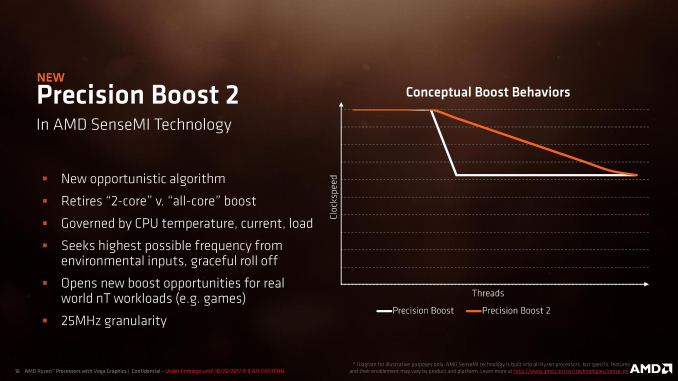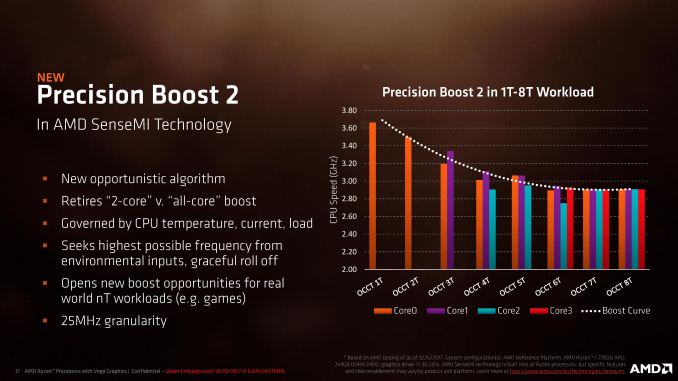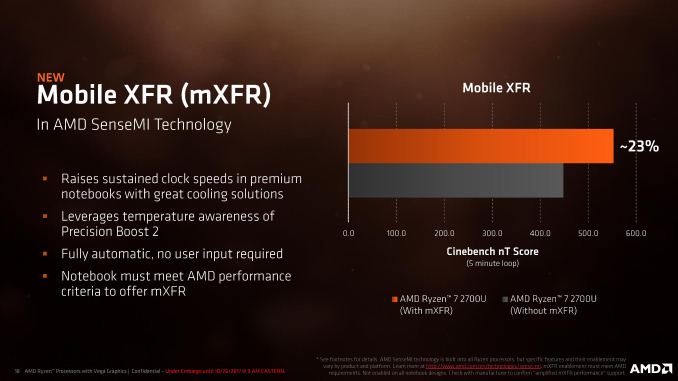Ryzen Mobile is Launched: AMD APUs for Laptops, with Vega and Updated Zen
by Ian Cutress on October 26, 2017 9:00 AM ESTSense Me Ryzen: Better Boost
When AMD launched the desktop Zen processors, it also branded a series of five technologies under the ‘SenseMI’ name. We covered these in detail in our Ryzen 7 review, but in short, it covers the following:
- Pure Power: Sensors to optimize power consumption
- Precision Boost: Determines how Turbo is applied
- Extreme Frequency Range: Going above maximum turbo when possible
- Neural Net Prediction: Using Neural Nets for prefetching data
- Smart Prefetch: Algorithms that work to enhance prefetch
With Ryzen Mobile, the features relating to frequency get an updated model, while Pure Power gets a bigger boost. We’ll cover the power changes on the next page, but it is worth talking about how AMD has improved Precision Boost and brought XFR to laptops.
Precision Boost 2
Most CPU turbo algorithms work by sensing how many cores and threads are under load, determining if the CPU has enough power headroom, and applying a voltage. This is why in the past both of the major x86 CPU manufacturers will quote a ‘per-core turbo frequency’ to show what the frequency should be when different numbers of cores are loaded and all else is fine (there is temperature/power headroom).
For Ryzen Mobile, AMD is pivoting to a new turbo model. When the system is in the P0 (top) turbo state, the system will use a new opportunistic turbo algorithm that rather than being based on the cores under load, is governed by CPU temperatures, currents, and how much load is being applied. The algorithm takes into account all the environmental inputs, such as skin temperature sensors and battery life, and will provide the best turbo frequency it can, regardless of if one thread is being used or all threads are being used.
It will be able to provide boost amounts at the 25 MHz granularity level, similar to how the desktop processors work, with the idea being that in most cases, if the system has a lot of cores available and a background process performs some very light work (such as checking for updates), rather than dropping 500-800 MHz because more cores are loaded, the system will keep at the high frequency.
AMD is stating that this has a big effect on real-world workloads, typically those that have variable thread workloads such as gaming.
When asked if Precision Boost 2 would be coming to the next generation of AMD’s Desktop Ryzen processors, I was told that ‘it could be inferred / it’s a safe bet’.
Mobile Extended Frequency Range (mXFR)
Because mobile systems are thermally limited, battery limited, power limited, and battery limited, offering ‘extra’ turbo headroom is not really something that processor manufacturers like to do. As a result, most of the Ryzen Mobile-powered notebooks will not have any form of XFR – AMD will be allowing it on a case-by-case basis for vendors that overengineer their chassis to be capable of supporting a higher power profile.
This feature essentially extends the average level at which Precision Boost 2 will operate, and also marks what could be considered a higher configurable TDP. One of the systems being launched with Ryzen Mobile this side of Christmas will be mXFR enabled, because the chassis is designed for 25W rather than 15W. It is worth noting that AMD states the configurable TDP of the Ryzen Mobile chips goes up to 25W, so this is likely the case what is happening.
Encode and Decode
AMD is fully using Vega’s encode and decode capabilities with Ryzen Mobile. The big inclusion for AMD’s mobile devices is the ability to decode VP9, the codec prefered in particular by YouTube.
| AMD Ryzen Mobile Encode/Decode Capabilities | |||||
| Decode 1080p @ 4:2:0 |
Decode 2160p @ 4:2:0 |
Encode 1080p |
Encode 1440p |
Encode 2160p |
|
| MPEG2 | 60 FPS | - | |||
| VC1 | 60 FPS | - | |||
| VP9 8/10 bpc | 240 FPS | 60 FPS | |||
| H.264 8 bpc | 240 FPS | 60 FPS | 120 FPS | 60 FPS | 30 FPS |
| H.264 10 bpc | 240 FPS | 60 FPS | |||
| HEVC 8bpc | 240 FPS | 60 FPS | 120 FPS | 60 FPS | 30 FPS |
| HEVC 10 bpc | 240 FPS | 60 FPS | |||
| JPEC 8bpc | 240 FPS | 60 FPS | |||













140 Comments
View All Comments
Rickyxds - Saturday, October 28, 2017 - link
i5 better than i7LordanSS - Saturday, October 28, 2017 - link
If a 15W part does this well... I'd say a 35-45W APU (which can be undervolted if necessary) with 4C/8T and ECC would make for a pretty awesome ZFS NAS....Lolimaster - Saturday, October 28, 2017 - link
The absurd efficiency of zen cores at low frequency really helps squeezing extra frequency from the gpu.From 700-800Mhz on avrg for mobile to 1.3Ghz is brutal.
deksman2 - Tuesday, November 7, 2017 - link
That's because of the manuf, process AMD uses.The GLOFO 14nm currently used for Ryzen and Vega is more suited for lower clocks not high ones.
It's one of the reasons why Vega has a higher power draw than Pascal in desktop space... its currently clocked too high and has too much unnecessary voltage (and we noted that undervolting Vega 56 can bring down power consumption to 1070 levels, while simultaneously overclocking it on the core and HBM would bring up performance to 1080 level but at a lower power draw than 1080.
At lower frequencies though, I would imagine that power draw would go down substantially for both Ryzen and Vega... plus, Ryzen is only using one CCX here, so that likely helps as well.
Will be really good if AMD decides to make a Raven Ridge 2 for example by making 8c/16th APU with Vega iGP's... all connected via Infinity Fabric of course on 7nm and same power draw.
I would imagine it would be doable, but at the same time, clocks would increase by a fairly good amount... the desktop could run on 5 GhZ base using upcoming 7nm manuf. process from IBM... as for Raven Ridge 2... possibly 3.2 GhZ base with 8 cores and 2 Navi iGP
hanselltc - Sunday, October 29, 2017 - link
Now all I need is a HP Envy 13 or a Razer Blade Stealth with this inside.Ro_Ja - Monday, October 30, 2017 - link
I'm looking forward to replacing my ASUS X550ZE-XX026H. Dual graphics is annoying. Can't even disable onboard GPU to use R5 M230.tyaty1 - Monday, October 30, 2017 - link
Thy look good, but if they can not support 16/32gb RAM, it is deal breaker.I have a Asus G551JW with 4200H, which performs very good, but I ant upgrade for quad core, which does not throttle, and it graphics performance is not much worse than the 960m.
tipoo - Monday, October 30, 2017 - link
Swift 3 will be interesting, wonder how this will compare to the MX150.neblogai - Monday, October 30, 2017 - link
I'd expect ~80% performance in 3DMark, and ~50% in games. Not just because of less bandwidth- but also because it runs with total 25W TDP for both CPU and GPU- while X150 system will run on approximately 40W (15W + 25W).